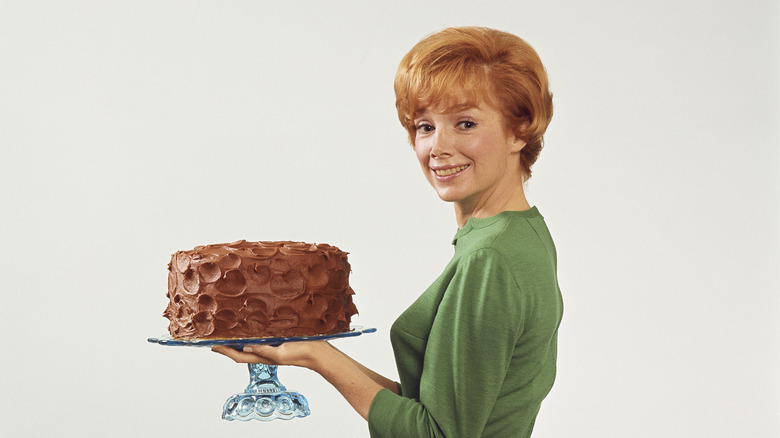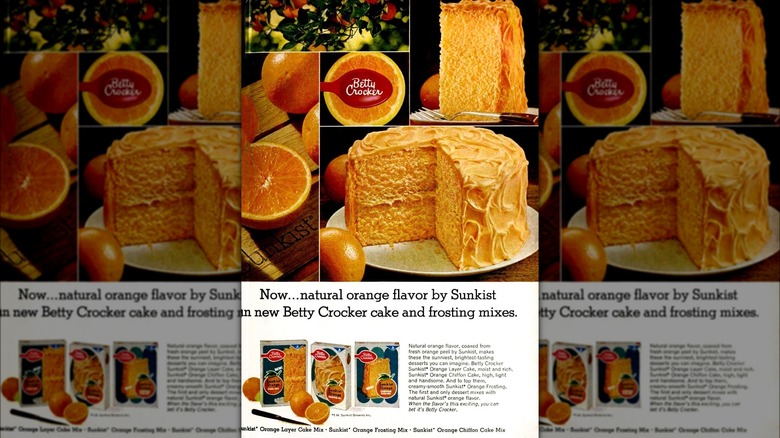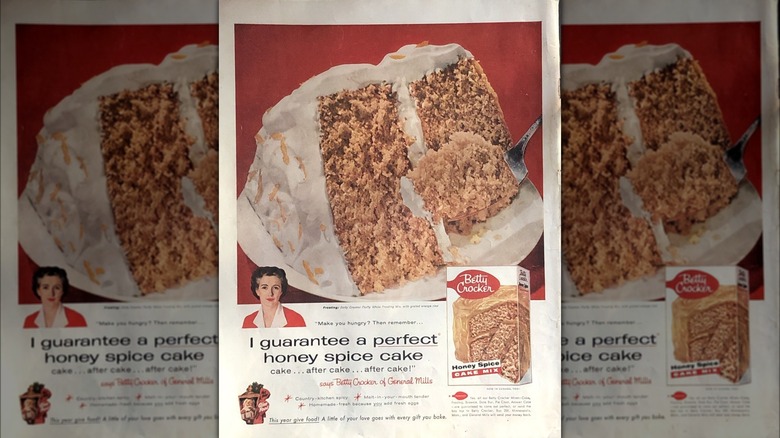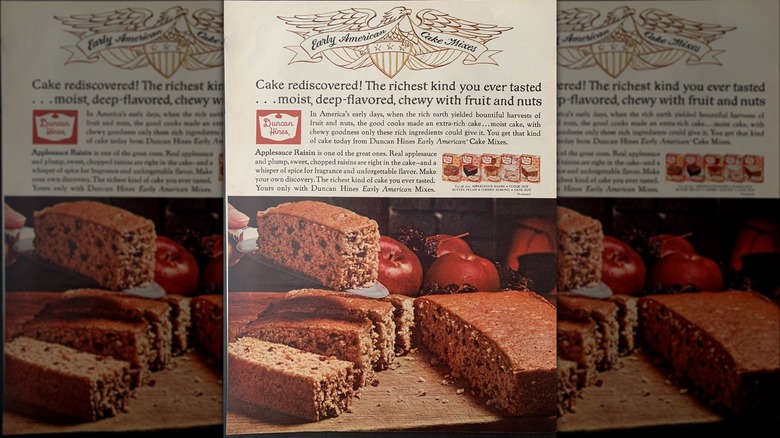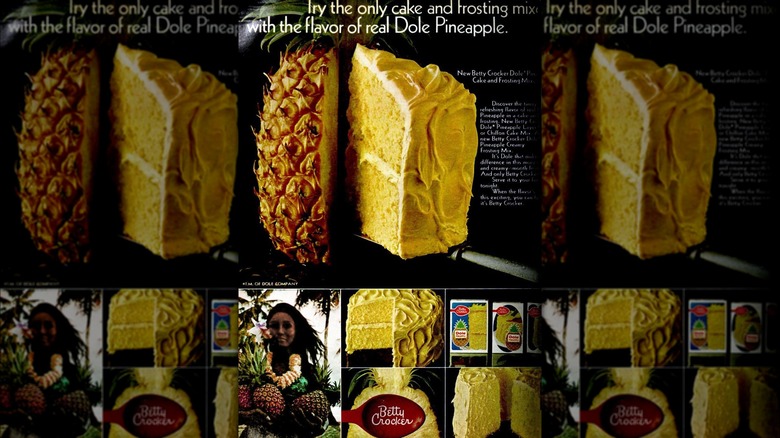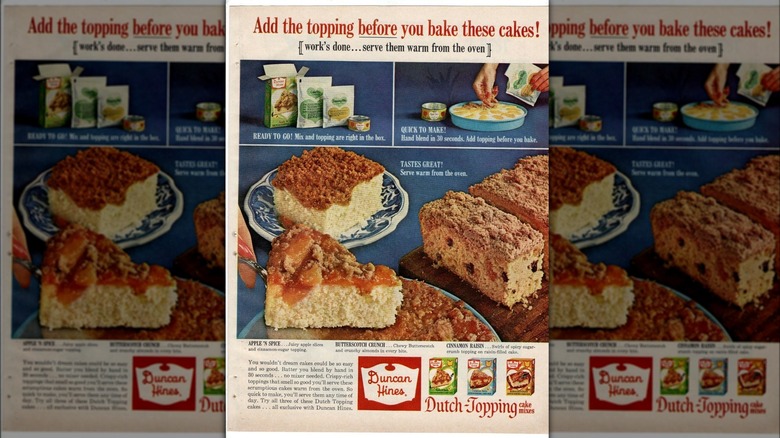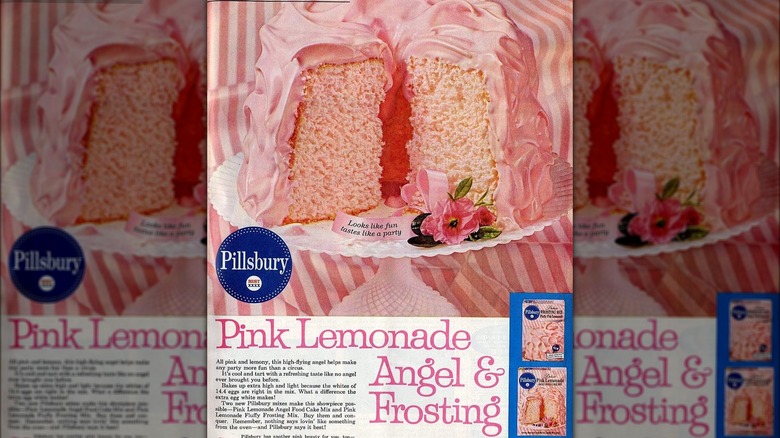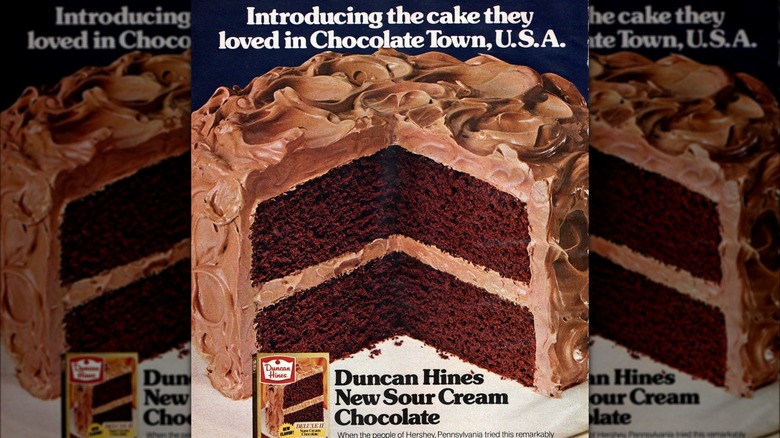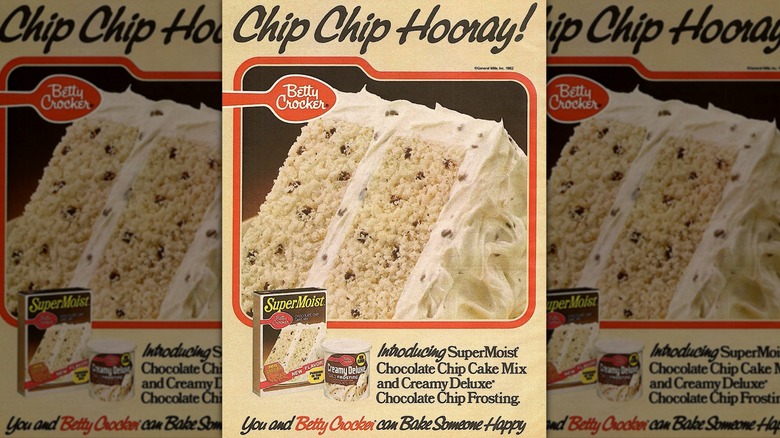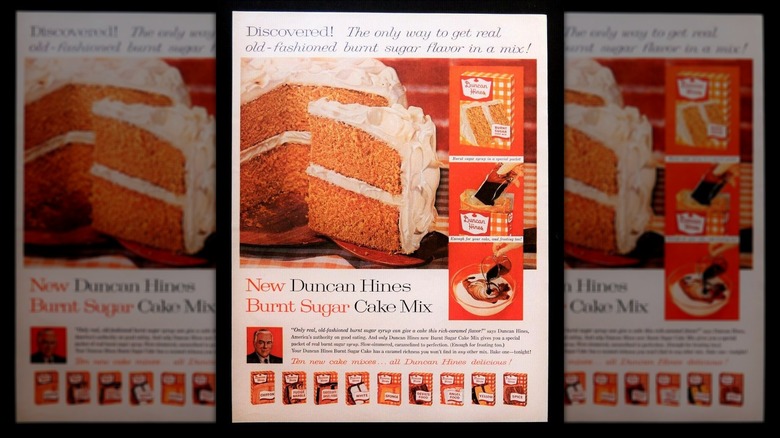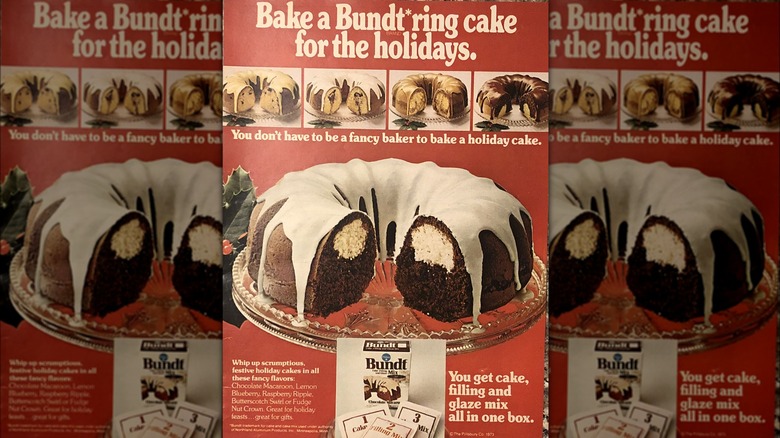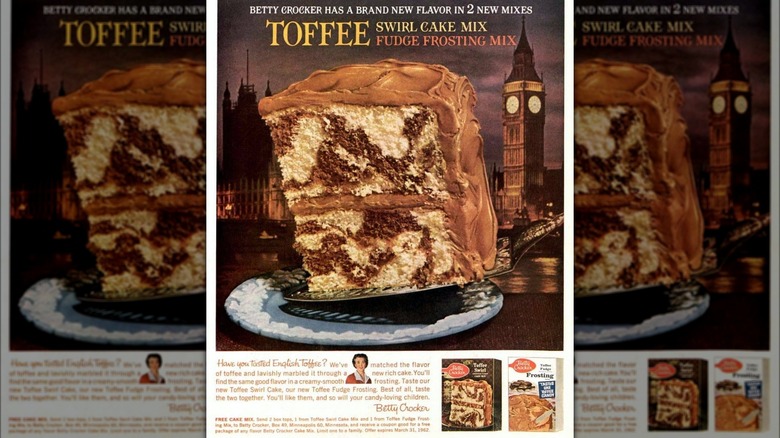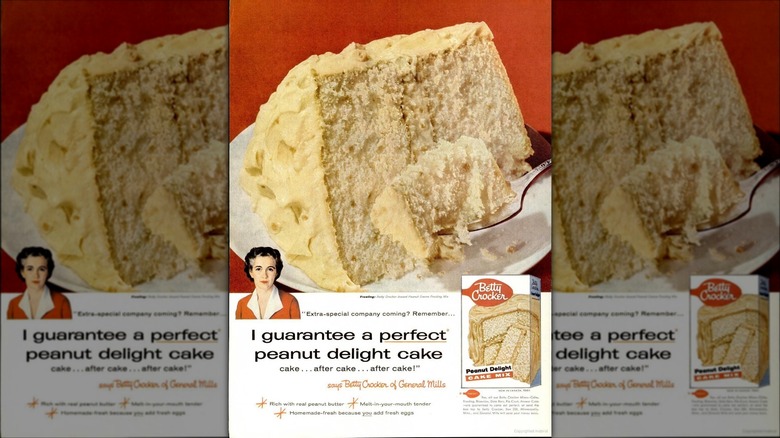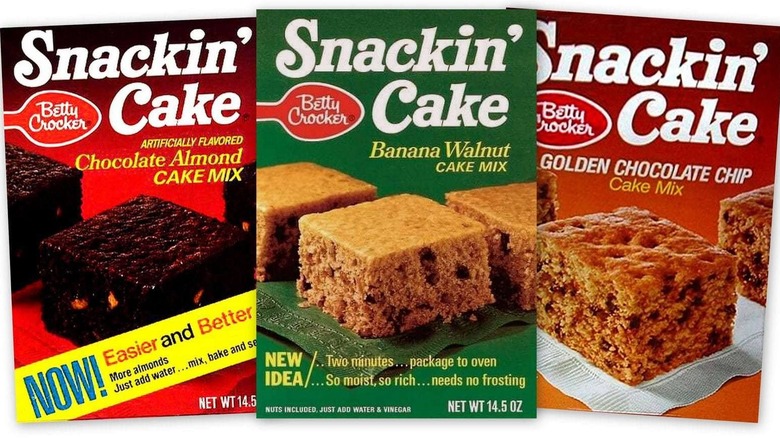15 Boxed Cake Flavors That Are Probably Gone Forever
Go to any grocery store and you will see a dozen different types of boxed cake mixes, ranging from plain yellow cake to devil's food to carrot cake. But did you know there are dozens of cake flavors that graced our store shelves only to be discontinued years later? For decades, the biggest brands in boxed mixes have been introducing new flavors to their lineups, only to take them away when they don't sell as well as the old standbys.
Boxed cake mixes boomed after WWII in the late 1940s. In 1947, Betty Crocker was the first to start selling mixes where all you had to do was add eggs, water, and vegetable oil. By 1951, Duncan Hines and Pillsbury were right behind Betty in a war that continues today. These three competitors have remained dominant for years; they have also introduced cake flavors that have since been discontinued. These 15 boxed cake flavors were gone forever before we even got to try them.
1. Betty Crocker Sunkist Orange Cake
In 1969, Betty Crocker made one of the most unlikely crossovers of her career. Sunkist is a leading brand of oranges that, these days, is mostly known for its soda. While Sunkist orange soda isn't exactly a flavor you associate with baked goods, orange cake used to be quite popular thanks to the same brand. Back in 1948, Betty Crocker's Orange Chiffon Cake recipe popularized the orange cake, a trend it tried to revitalize in the '60s.
Betty Crocker's Sunkist Orange Cake had a much brighter orange color to it than chiffon cake, though. Especially when you used the Betty Crocker Sunkist Orange frosting, sold separately. This cake mix and corresponding frosting flavor were sold in the late '60s. While we missed this one by a good 30 years, we don't think it sounds especially appetizing. For a more contemporary take on an orange dessert, we recommend you try this cranberry orange bundt cake.
2. Betty Crocker Chocolate Malt Cake
If you're a beer aficionado or you just hang out at old-timey soda shops, you know what malts are. To become malt, a cereal grain has to go through the "malting" process, which, through steeping and germinating, gives it its specific flavor and color. Add malted barley to evaporated milk, and you have malted milk powder, the basis for the milkshake-like treat that is also called "a malted" by some. It's also a popular chocolate cake flavor, or at least it was.
Malted milk powder is added to cake to give it that unique, toasted malt flavor and to ensure a tender texture. With Betty Crocker's Chocolate Malt Cake Mix, you didn't even have to provide your own malted milk; it was right there in the mixture.
This Betty Crocker malted cake mix was advertised on TV and in print from 1956 until around 1962. A mix for instant chocolate malt frosting was sold simultaneously.
3. Betty Crocker Honey Spice Cake
This discontinued Betty Crocker flavor goes back to a time before the brand debuted its iconic red spoon logo. The oldest images of the Honey Spice Cake Mix we can find are from 1953, a year before General Mills introduced the world to its new logo. This cake mix was being sold in grocery stores as early as 1947. That same year, Betty Crocker debuted its easy recipe for "Mystery Fruitcake." This recipe encouraged bakers to buy the brand's Honey Spice Cake Mix and use it as this cake's base before adding an assortment of fruits and nuts to transform it into a fruitcake.
This cake was most likely similar to the type of traditional honey cake a Jewish household might make on Rosh Hashanah. It's a fairly simple, moist cake that is sweet and lightly spiced. A good honey cake is so moist there isn't any need for frosting, despite what Betty Crocker says to try and sell more mixes. Images from General Mills show that the Honey Spice Cake lived on into the red spoon logo era, and that it was sold throughout the rest of the 1950s.
4. Duncan Hines Applesauce Raisin Cake
If you've never thought about putting applesauce in a cake you're not alone. Even when this Duncan Hines box mix came out in the 1960s, it was a throwback.
Who has time to cook a pot of applesauce just to put it into a cake like they did in colonial times? An advertisement from 1961 calls back to these olden days of American settler-colonialism, when an Applesauce Raisin cake would've been popular. This rich cake is so moist that it "doesn't even need frosting," according to the ad's narrator. It doesn't look like the kind of cake that would taste good frosted anyway.
The Duncan Hines Applesauce Raisin cake mix sold in the '60s contained both raisins and (dehydrated) apple sauce, as well as fragrant spices, in its box. At the same time, the company was also selling Butter Pecan and Fudge Nut varieties of the brand's line of "Early American" cake mixes, inspired by the colonial days.
5. Betty Crocker Dole Pineapple Cake
In the late '60s, Betty Crocker was doing crossover items like it was the Marvel Cinematic Universe of the era. Maybe that's a slight exaggeration, but this product proves it wasn't just the Sunkist cake mix that was advertised this decade, but a partnership with Dole as well. The Betty Crocker Dole Pineapple cake mix was available in 1969. It was sold alongside a pineapple-flavored frosting mix to accompany it.
We love pineapple, but looking at this sweet and tart creation, we can tell it was not for the faint of heart. One can only handle so much pineapple flavor, and this cake and frosting combo seems to have crossed that line. If it were a popular recipe, it wouldn't have vanished into thin air. Nowadays, the fruit is much more popular in the form of pineapple upside-down cake, which is a more balanced take on the concept of pineapple cake.
6. Duncan Hines Dutch Topping Cake Mixes
When you hear the words "Dutch crunch," you might immediately think of Northern California's signature bread, also called Tiger Bread. But these Duncan Hines Dutch Topping Cake mixes had little in common with that sandwich bread and instead were more similar to coffee cakes. The mixes provided an easy way to make seemingly complex cakes, all three of which feature a sweet, crunchy sugar crumb topping. Unfortunately, nothing like them exists today, and this line of Duncan Hines cake mixes seems to have gone nearly extinct in the '60s.
The Dutch Topping Duncan Hines boxed cake mixes included three different flavors: Butterscotch Crunch, Apple N' Spice, and Cinnamon Raisin. Each box of Dutch Topping cake mix included the mixtures for the cake and the topping, as well as the fillings (apples, raisins, etc.) required for the cake. Honestly, both the Butterscotch Crunch and Apple N' Spice sound right up our alley, but we would likely pass on the Cinnamon Raisin flavor.
7. Pillsbury Pink Lemonade Angel Food Cake
This is a strange one, and not just because Pillsbury's marketing claimed it would make your party "more fun than a circus," which apparently was a high bar in 1961 when that advertisement ran in Better Homes and Gardens. This boxed Pink Lemonade Angel Food cake mix took on the sweet and sour flavor profile of everyone's favorite childhood summer beverage. It was sold with a corresponding Pink Lemonade Frosting Mix.
While boxed cake mixes were common by this point in history, they were (and still are) primarily used to make sponge cake. Its lighter, airier cousin, the angel food cake, derives its unique texture from a high volume of whipped egg whites. This Pink Lemonade angel food cake mix included the whites of 14.4 eggs, although how exactly Pillsbury did that is a mystery lost to time. We are guessing there were powdered egg whites in the mix.
8. Duncan Hines Sour Cream Chocolate Cake
If you have any experience making baked goods, you might know about the secret use for sour cream. The dairy product that is typically served on tacos or baked potatoes can be an excellent way to increase the moisture of your cakes or donuts while adding flavor at the same time. It can be a lot like buttermilk in that way. Back in the 1970s, the Duncan Hines company introduced Sour Cream Chocolate Cake to its boxed mix lineup for a limited time.
A 1977 print ad marketed this cake mix as a chocolate lovers' delight. The ad showed pictures from Hershey, Pennsylvania, and called it "the cake they loved in Chocolate Town, USA." The assumption is that if you lived in Hershey, you knew your chocolate. Considering the flavor is not around today, we're going to assume people didn't quite fall for the line the way Duncan Hines had hoped.
If you read all that and you are now craving sour cream cake, try our recipe for this modern take on sour cream chocolate cake. It's a great way to use up that leftover cup of sour cream you probably have tucked away in the fridge.
9. Betty Crocker Chocolate Chip Cake
While Betty Crocker sells mixes to make chocolate chip cookies and muffins, you might find the lack of a chocolate chip cake mix disturbing. The truth is that for many years, the General Mills brand did sell a Chocolate Chip Cake box mix, but it hasn't been on store shelves for a number of decades. We know, based when it was advertised, that this mix was available between the years of 1982 and 1990.
Chocolate Chip Cake is a flavor that goes back even further than the '80s. Unsurprisingly, Betty Crocker published a recipe for chocolate chip cake all the way back in 1947. The white cake dotted with chocolate chips is pretty similar to the one found in a box mix the company sold decades later. The advertisements from the early '80s claimed that this cake was "SuperMoist." They also showed a complimentary Chocolate Chip Frosting Mix from Betty Crocker with the same flavor profile.
10. Duncan Hines Burnt Sugar Cake
Burnt is the last thing you want your cake to be. But burnt sugar is a different beast, and if done correctly, it can make a dessert sing. Caramel is what we call the flavor profile of burnt sugar. Caramel is a deeper, darker brown color than regular sugar and provides an enhanced buttery flavor that leaves you craving more. That's what, based on historical evidence, we can assume this Duncan Hines boxed cake tasted like when it was available circa 1958.
This box mix Burnt Sugar Cake was a caramel bomb, with the rich flavor reinforced throughout both the sponge and the frosting. A Duncan Hines ad from that same year claimed that the secret ingredient is "real caramel syrup made from pure sugar, melted and slowly simmered for hours... then sealed in an airtight packet at the peak of its goodness." The box included enough of this syrup to add to your frosting too.
11. Pillsbury Bundt Cakes Mixes
In the 1970s, bundt cakes were all the rage. It was a trend that died down in the '80s due to the invention of the microwave, as Dana Norsten, public relations and communication manager for Nordic Ware, told the Columbus Dispatch. Made upside-down in a bundt pan, these circular cakes are perfect for slicing and sharing. As early as 1973, Pillsbury leaned into this with its line of Bundt Cake box mixes.
In a 1973 TV commercial, we get a nice look at the Chocolate Macaroon Bundt cake from Pillsbury. This chocolate bundt cake was filled with macaroons, small sweet cookies made with shaved coconut, and glazed in white icing. The mix came with the ingredients to make all three elements. This was just one of five cakes that Pillsbury offered under its short-lived Bundt cake brand. Other flavors included Lemon Blueberry and Fudge Nut Ring.
12. Betty Crocker Toffee Swirl Cake
Okay, now this one we wish we could try. Our mouths are watering based on the way it looks on a 1962 ad, where you can see the swirls of golden brown toffee in a gorgeous white cake. The Betty Crocker Toffee Swirl Cake is a marble cake featuring the flavors of English toffee, a buttery and toasted sugar-based candy that often comes in a brittle form. Sometimes it can manifest in other ways, like the old-fashioned cake-like dessert sticky toffee pudding.
While this Betty Crocker boxed cake likely lacked the textural element of toffee, the flavor probably could have worked quite well. At the same time, Betty Crocker was also selling an instant Toffee Fudge Frosting Mix that combined the flavors of toffee and chocolate.
It seems like the company was pushing this new product pretty hard. In early 1962, if you sent in a box top (remember those?) from both the cake and frosting mix, you would receive a coupon redeemable for any flavor of Betty Crocker cake mix. It's not a bad deal by today's standards.
13. Betty Crocker Peanut Delight Cake
Who among us doesn't love a peanut butter dessert? Aside from those allergic to tree nuts, we can't say we've met many people who can say no to the sinful combination of peanut butter and sugar. Betty Crocker took advantage of this with one of its many boxed cake mix flavors that was sold only in the 1950s. Peanut Delight hasn't been a cake flavor for decades, but we sincerely wish we had a time machine to go back and try it.
This Betty Crocker dry mix was made using real peanut butter to infuse a peanut flavor throughout the dessert. If you wanted to double down on the peanut butter flavor, you could also pick up a packet of instant Peanut Creme Frosting Mix from Betty Crocker as well. However, we imagine that the brand's Chocolate Fudge and Chocolate Malt frostings (sold contemporaneously) would be a great fit for us Reese's lovers out here.
14. Betty Crocker Black Walnut Cake
It's somewhat ironic that Betty Crocker's Black Walnut cake mix has been forgotten since its slogan was "Betty Crocker's newest mix to make you famous." Or at least, this is what a 1958 print ad for the product said. This boxed mix was among Betty Crocker's lineup throughout the '50s, alongside such previously mentioned canceled flavors as Peanut Delight and Honey Spice.
Black walnut cake is a relic of the past that you may only remember through family recipes passed down over generations. The origins stretch back to Pennsylvania Dutch country in America's colonial times. It's a very simple sponge cake with walnuts folded in and also used as a topping. A sour cream frosting is typically what you might find on a walnut cake. Betty Crocker's mix promised the flavor of black walnuts, although it doesn't seem like any chunks were included in the package itself.
15. Betty Crocker Snackin' Cakes
Throughout the '70s and '80s, Betty Crocker sold a very popular line of cake mixes that you can no longer find on store shelves. These were Snackin' Cakes, or snacking cakes, which are quite different from a snack cake. The latter are what we call pre-packaged Little Debbie and Hostess treats. The former once meant an easy-to-make convenient homemade baked good, but in 1971, General Mills purchased and trademarked the term in order to promote this line of products. These cake mixes were made to be dumped, mixed, and baked in one pan. Each one included a special surprise inside; each one with some filling of nuts, chocolate, or fruit.
Flavors of Betty Crocker Snackin' Cakes included (but were not limited to) Banana Walnut, Golden Chocolate Chip, Applesauce Raisin, and Chocolate Walnut. This popular brand of Betty Crocker cakes continued to be sold throughout the 1980s.
